Logistics and Supply Chain Management: Samsung Case Study Analysis
VerifiedAdded on 2023/05/28
|17
|3781
|138
Report
AI Summary
This report provides a comprehensive analysis of Samsung's supply chain management. It begins with an executive summary outlining the significance of supply chain management in the business world and highlights Samsung's strategies for maintaining competitiveness. The report delves into the key flows within Samsung's supply network, focusing on the make process and its connection to Exchange Theory. It explores Samsung's approach to procurement and the various types of forecasting models used. The discussion covers the integration of key business processes, from raw material procurement to end-customer delivery. The report also provides insights into Samsung's production planning and scheduling processes, including the use of Adexa's Supply Chain Planning and Factory Planning and Scheduling. The analysis emphasizes the importance of collaborative demand planning and the benefits of efficient production planning systems. The report concludes by offering recommendations for improving Samsung's supply chain management and enhancing its overall efficiency.
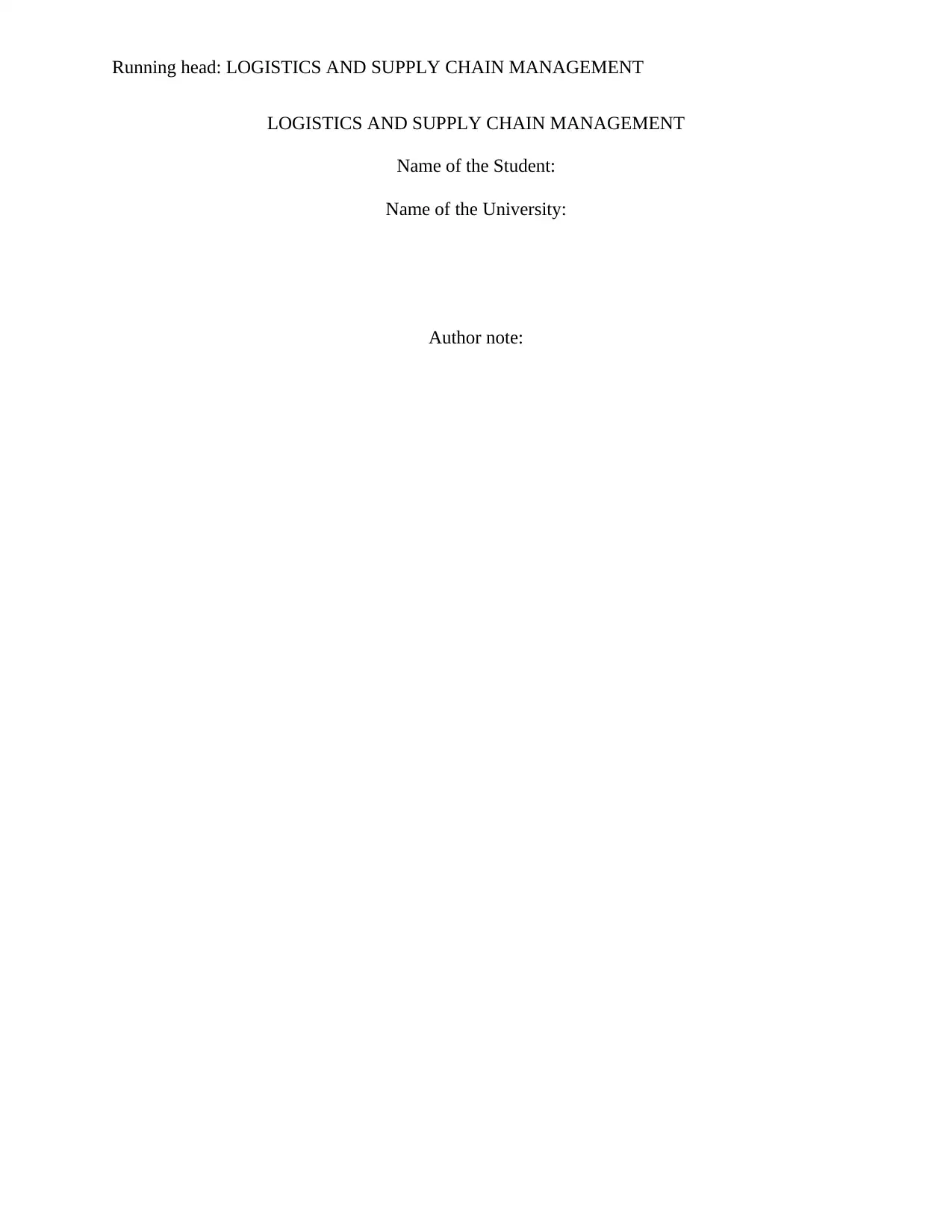
Running head: LOGISTICS AND SUPPLY CHAIN MANAGEMENT
LOGISTICS AND SUPPLY CHAIN MANAGEMENT
Name of the Student:
Name of the University:
Author note:
LOGISTICS AND SUPPLY CHAIN MANAGEMENT
Name of the Student:
Name of the University:
Author note:
Paraphrase This Document
Need a fresh take? Get an instant paraphrase of this document with our AI Paraphraser
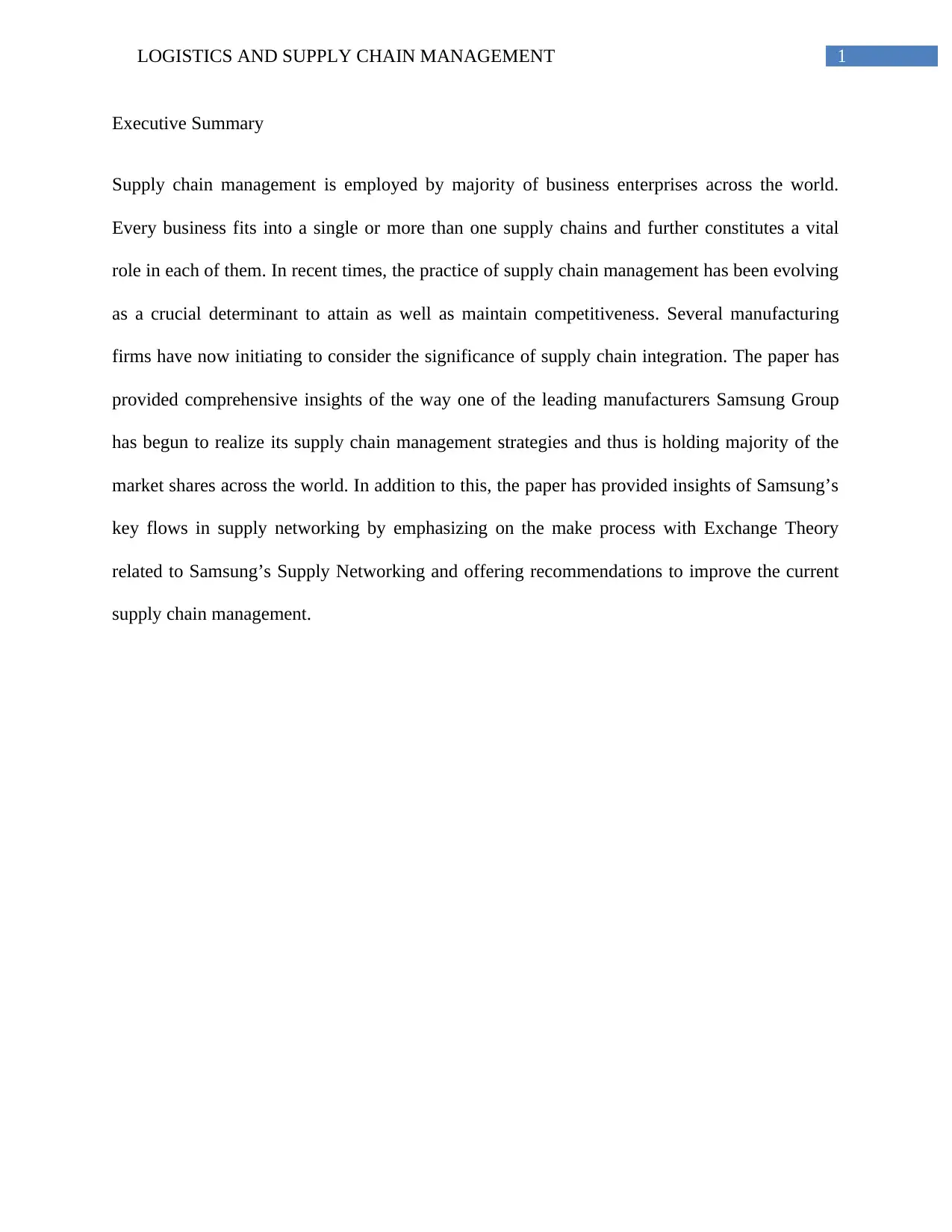
1LOGISTICS AND SUPPLY CHAIN MANAGEMENT
Executive Summary
Supply chain management is employed by majority of business enterprises across the world.
Every business fits into a single or more than one supply chains and further constitutes a vital
role in each of them. In recent times, the practice of supply chain management has been evolving
as a crucial determinant to attain as well as maintain competitiveness. Several manufacturing
firms have now initiating to consider the significance of supply chain integration. The paper has
provided comprehensive insights of the way one of the leading manufacturers Samsung Group
has begun to realize its supply chain management strategies and thus is holding majority of the
market shares across the world. In addition to this, the paper has provided insights of Samsung’s
key flows in supply networking by emphasizing on the make process with Exchange Theory
related to Samsung’s Supply Networking and offering recommendations to improve the current
supply chain management.
Executive Summary
Supply chain management is employed by majority of business enterprises across the world.
Every business fits into a single or more than one supply chains and further constitutes a vital
role in each of them. In recent times, the practice of supply chain management has been evolving
as a crucial determinant to attain as well as maintain competitiveness. Several manufacturing
firms have now initiating to consider the significance of supply chain integration. The paper has
provided comprehensive insights of the way one of the leading manufacturers Samsung Group
has begun to realize its supply chain management strategies and thus is holding majority of the
market shares across the world. In addition to this, the paper has provided insights of Samsung’s
key flows in supply networking by emphasizing on the make process with Exchange Theory
related to Samsung’s Supply Networking and offering recommendations to improve the current
supply chain management.
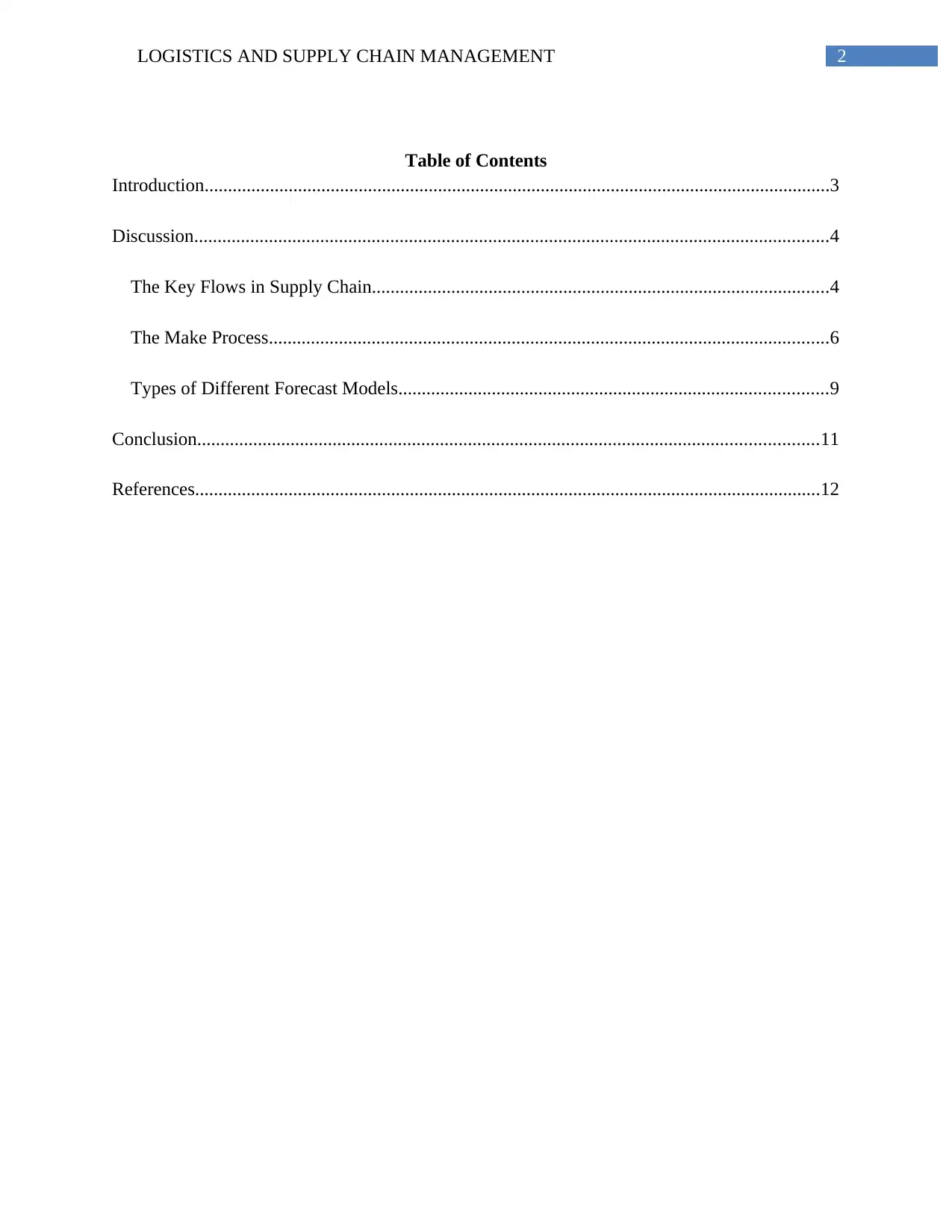
2LOGISTICS AND SUPPLY CHAIN MANAGEMENT
Table of Contents
Introduction......................................................................................................................................3
Discussion........................................................................................................................................4
The Key Flows in Supply Chain..................................................................................................4
The Make Process........................................................................................................................6
Types of Different Forecast Models............................................................................................9
Conclusion.....................................................................................................................................11
References......................................................................................................................................12
Table of Contents
Introduction......................................................................................................................................3
Discussion........................................................................................................................................4
The Key Flows in Supply Chain..................................................................................................4
The Make Process........................................................................................................................6
Types of Different Forecast Models............................................................................................9
Conclusion.....................................................................................................................................11
References......................................................................................................................................12
⊘ This is a preview!⊘
Do you want full access?
Subscribe today to unlock all pages.

Trusted by 1+ million students worldwide
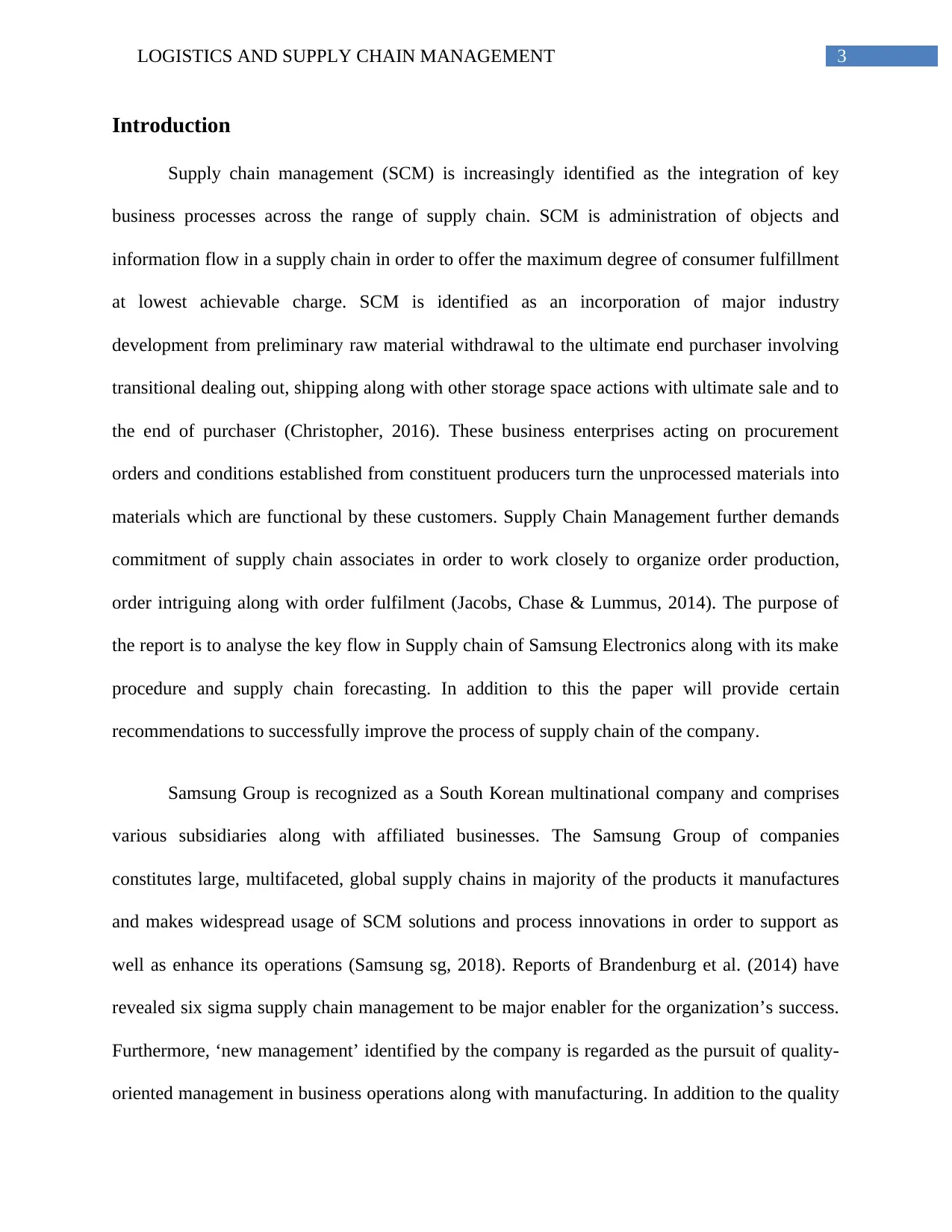
3LOGISTICS AND SUPPLY CHAIN MANAGEMENT
Introduction
Supply chain management (SCM) is increasingly identified as the integration of key
business processes across the range of supply chain. SCM is administration of objects and
information flow in a supply chain in order to offer the maximum degree of consumer fulfillment
at lowest achievable charge. SCM is identified as an incorporation of major industry
development from preliminary raw material withdrawal to the ultimate end purchaser involving
transitional dealing out, shipping along with other storage space actions with ultimate sale and to
the end of purchaser (Christopher, 2016). These business enterprises acting on procurement
orders and conditions established from constituent producers turn the unprocessed materials into
materials which are functional by these customers. Supply Chain Management further demands
commitment of supply chain associates in order to work closely to organize order production,
order intriguing along with order fulfilment (Jacobs, Chase & Lummus, 2014). The purpose of
the report is to analyse the key flow in Supply chain of Samsung Electronics along with its make
procedure and supply chain forecasting. In addition to this the paper will provide certain
recommendations to successfully improve the process of supply chain of the company.
Samsung Group is recognized as a South Korean multinational company and comprises
various subsidiaries along with affiliated businesses. The Samsung Group of companies
constitutes large, multifaceted, global supply chains in majority of the products it manufactures
and makes widespread usage of SCM solutions and process innovations in order to support as
well as enhance its operations (Samsung sg, 2018). Reports of Brandenburg et al. (2014) have
revealed six sigma supply chain management to be major enabler for the organization’s success.
Furthermore, ‘new management’ identified by the company is regarded as the pursuit of quality-
oriented management in business operations along with manufacturing. In addition to the quality
Introduction
Supply chain management (SCM) is increasingly identified as the integration of key
business processes across the range of supply chain. SCM is administration of objects and
information flow in a supply chain in order to offer the maximum degree of consumer fulfillment
at lowest achievable charge. SCM is identified as an incorporation of major industry
development from preliminary raw material withdrawal to the ultimate end purchaser involving
transitional dealing out, shipping along with other storage space actions with ultimate sale and to
the end of purchaser (Christopher, 2016). These business enterprises acting on procurement
orders and conditions established from constituent producers turn the unprocessed materials into
materials which are functional by these customers. Supply Chain Management further demands
commitment of supply chain associates in order to work closely to organize order production,
order intriguing along with order fulfilment (Jacobs, Chase & Lummus, 2014). The purpose of
the report is to analyse the key flow in Supply chain of Samsung Electronics along with its make
procedure and supply chain forecasting. In addition to this the paper will provide certain
recommendations to successfully improve the process of supply chain of the company.
Samsung Group is recognized as a South Korean multinational company and comprises
various subsidiaries along with affiliated businesses. The Samsung Group of companies
constitutes large, multifaceted, global supply chains in majority of the products it manufactures
and makes widespread usage of SCM solutions and process innovations in order to support as
well as enhance its operations (Samsung sg, 2018). Reports of Brandenburg et al. (2014) have
revealed six sigma supply chain management to be major enabler for the organization’s success.
Furthermore, ‘new management’ identified by the company is regarded as the pursuit of quality-
oriented management in business operations along with manufacturing. In addition to the quality
Paraphrase This Document
Need a fresh take? Get an instant paraphrase of this document with our AI Paraphraser
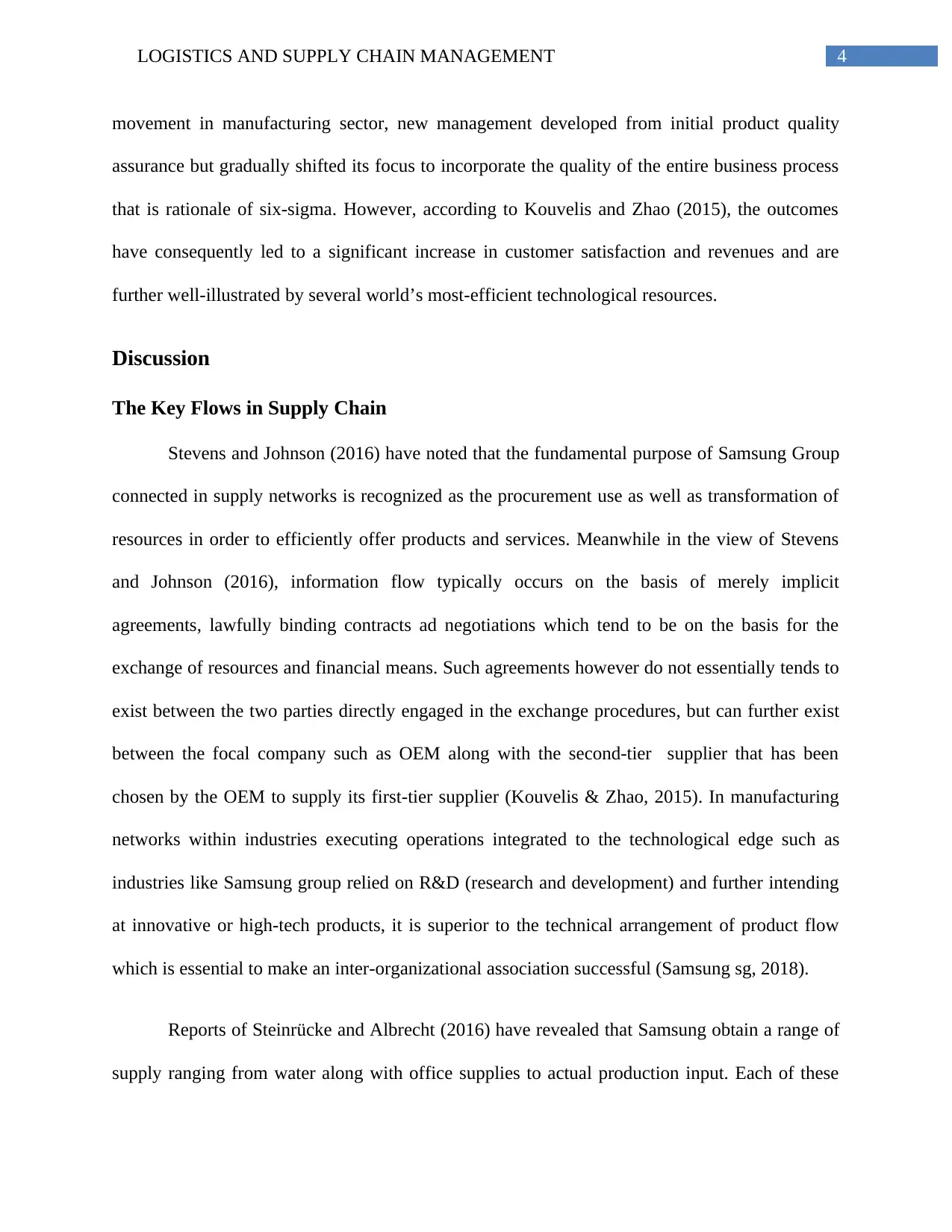
4LOGISTICS AND SUPPLY CHAIN MANAGEMENT
movement in manufacturing sector, new management developed from initial product quality
assurance but gradually shifted its focus to incorporate the quality of the entire business process
that is rationale of six-sigma. However, according to Kouvelis and Zhao (2015), the outcomes
have consequently led to a significant increase in customer satisfaction and revenues and are
further well-illustrated by several world’s most-efficient technological resources.
Discussion
The Key Flows in Supply Chain
Stevens and Johnson (2016) have noted that the fundamental purpose of Samsung Group
connected in supply networks is recognized as the procurement use as well as transformation of
resources in order to efficiently offer products and services. Meanwhile in the view of Stevens
and Johnson (2016), information flow typically occurs on the basis of merely implicit
agreements, lawfully binding contracts ad negotiations which tend to be on the basis for the
exchange of resources and financial means. Such agreements however do not essentially tends to
exist between the two parties directly engaged in the exchange procedures, but can further exist
between the focal company such as OEM along with the second-tier supplier that has been
chosen by the OEM to supply its first-tier supplier (Kouvelis & Zhao, 2015). In manufacturing
networks within industries executing operations integrated to the technological edge such as
industries like Samsung group relied on R&D (research and development) and further intending
at innovative or high-tech products, it is superior to the technical arrangement of product flow
which is essential to make an inter-organizational association successful (Samsung sg, 2018).
Reports of Steinrücke and Albrecht (2016) have revealed that Samsung obtain a range of
supply ranging from water along with office supplies to actual production input. Each of these
movement in manufacturing sector, new management developed from initial product quality
assurance but gradually shifted its focus to incorporate the quality of the entire business process
that is rationale of six-sigma. However, according to Kouvelis and Zhao (2015), the outcomes
have consequently led to a significant increase in customer satisfaction and revenues and are
further well-illustrated by several world’s most-efficient technological resources.
Discussion
The Key Flows in Supply Chain
Stevens and Johnson (2016) have noted that the fundamental purpose of Samsung Group
connected in supply networks is recognized as the procurement use as well as transformation of
resources in order to efficiently offer products and services. Meanwhile in the view of Stevens
and Johnson (2016), information flow typically occurs on the basis of merely implicit
agreements, lawfully binding contracts ad negotiations which tend to be on the basis for the
exchange of resources and financial means. Such agreements however do not essentially tends to
exist between the two parties directly engaged in the exchange procedures, but can further exist
between the focal company such as OEM along with the second-tier supplier that has been
chosen by the OEM to supply its first-tier supplier (Kouvelis & Zhao, 2015). In manufacturing
networks within industries executing operations integrated to the technological edge such as
industries like Samsung group relied on R&D (research and development) and further intending
at innovative or high-tech products, it is superior to the technical arrangement of product flow
which is essential to make an inter-organizational association successful (Samsung sg, 2018).
Reports of Steinrücke and Albrecht (2016) have revealed that Samsung obtain a range of
supply ranging from water along with office supplies to actual production input. Each of these
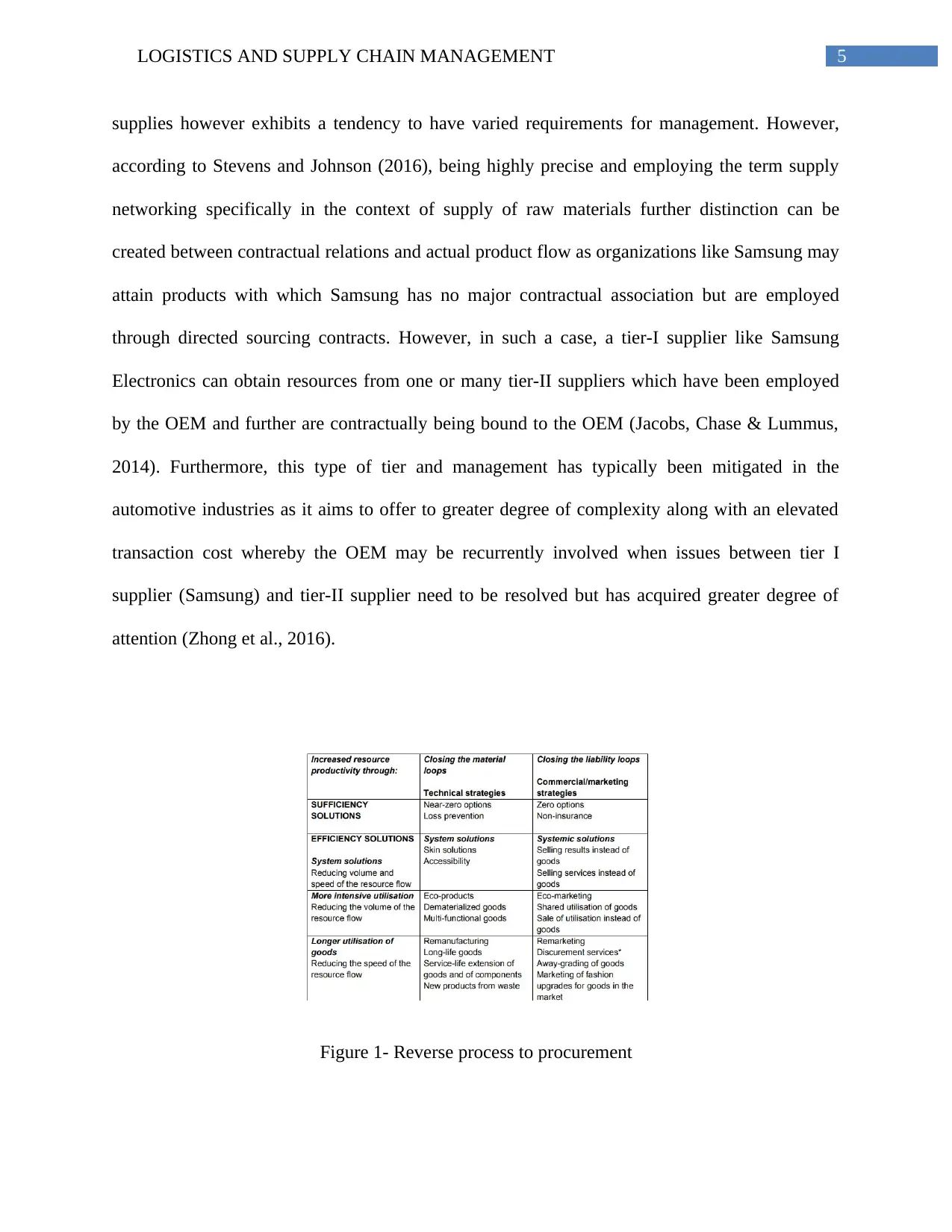
5LOGISTICS AND SUPPLY CHAIN MANAGEMENT
supplies however exhibits a tendency to have varied requirements for management. However,
according to Stevens and Johnson (2016), being highly precise and employing the term supply
networking specifically in the context of supply of raw materials further distinction can be
created between contractual relations and actual product flow as organizations like Samsung may
attain products with which Samsung has no major contractual association but are employed
through directed sourcing contracts. However, in such a case, a tier-I supplier like Samsung
Electronics can obtain resources from one or many tier-II suppliers which have been employed
by the OEM and further are contractually being bound to the OEM (Jacobs, Chase & Lummus,
2014). Furthermore, this type of tier and management has typically been mitigated in the
automotive industries as it aims to offer to greater degree of complexity along with an elevated
transaction cost whereby the OEM may be recurrently involved when issues between tier I
supplier (Samsung) and tier-II supplier need to be resolved but has acquired greater degree of
attention (Zhong et al., 2016).
Figure 1- Reverse process to procurement
supplies however exhibits a tendency to have varied requirements for management. However,
according to Stevens and Johnson (2016), being highly precise and employing the term supply
networking specifically in the context of supply of raw materials further distinction can be
created between contractual relations and actual product flow as organizations like Samsung may
attain products with which Samsung has no major contractual association but are employed
through directed sourcing contracts. However, in such a case, a tier-I supplier like Samsung
Electronics can obtain resources from one or many tier-II suppliers which have been employed
by the OEM and further are contractually being bound to the OEM (Jacobs, Chase & Lummus,
2014). Furthermore, this type of tier and management has typically been mitigated in the
automotive industries as it aims to offer to greater degree of complexity along with an elevated
transaction cost whereby the OEM may be recurrently involved when issues between tier I
supplier (Samsung) and tier-II supplier need to be resolved but has acquired greater degree of
attention (Zhong et al., 2016).
Figure 1- Reverse process to procurement
⊘ This is a preview!⊘
Do you want full access?
Subscribe today to unlock all pages.

Trusted by 1+ million students worldwide
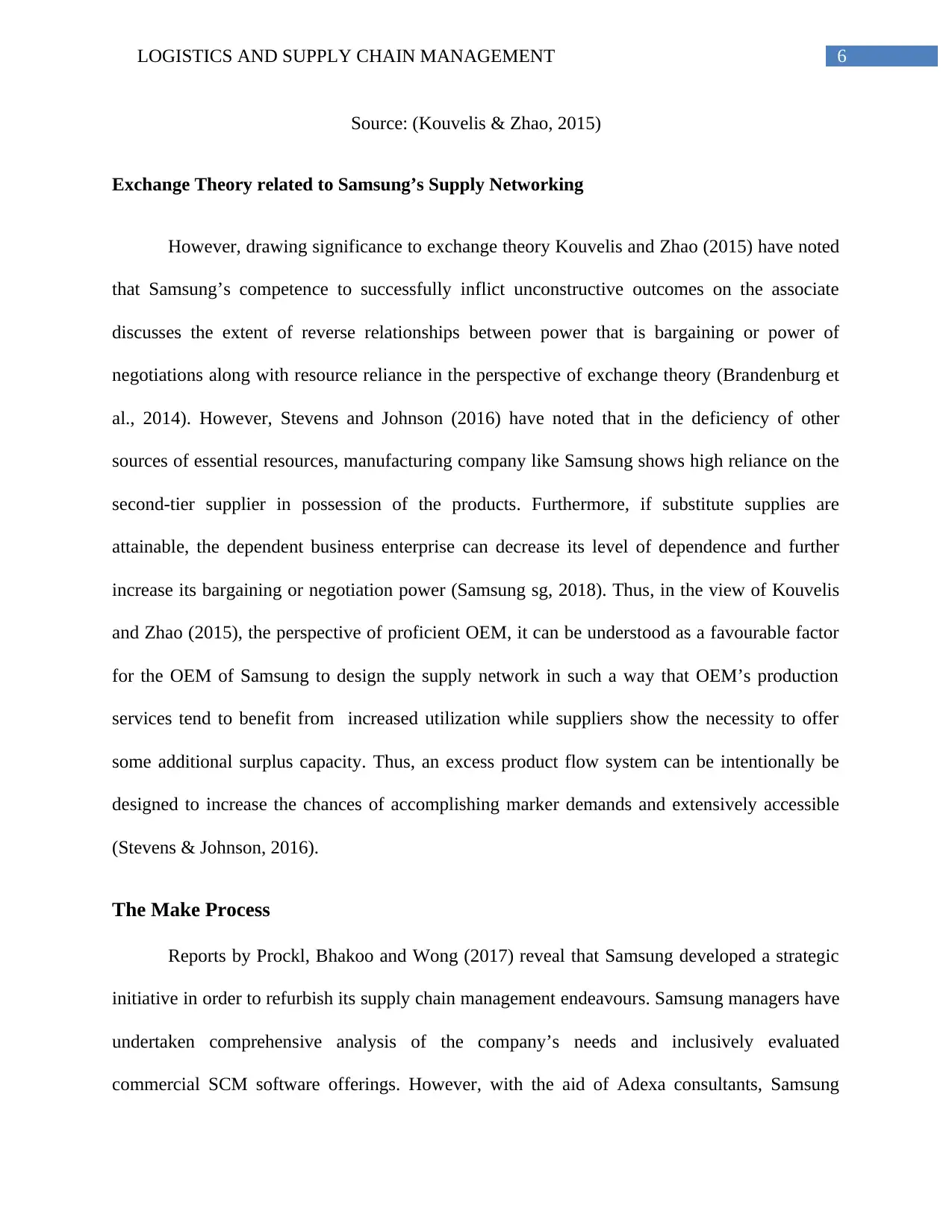
6LOGISTICS AND SUPPLY CHAIN MANAGEMENT
Source: (Kouvelis & Zhao, 2015)
Exchange Theory related to Samsung’s Supply Networking
However, drawing significance to exchange theory Kouvelis and Zhao (2015) have noted
that Samsung’s competence to successfully inflict unconstructive outcomes on the associate
discusses the extent of reverse relationships between power that is bargaining or power of
negotiations along with resource reliance in the perspective of exchange theory (Brandenburg et
al., 2014). However, Stevens and Johnson (2016) have noted that in the deficiency of other
sources of essential resources, manufacturing company like Samsung shows high reliance on the
second-tier supplier in possession of the products. Furthermore, if substitute supplies are
attainable, the dependent business enterprise can decrease its level of dependence and further
increase its bargaining or negotiation power (Samsung sg, 2018). Thus, in the view of Kouvelis
and Zhao (2015), the perspective of proficient OEM, it can be understood as a favourable factor
for the OEM of Samsung to design the supply network in such a way that OEM’s production
services tend to benefit from increased utilization while suppliers show the necessity to offer
some additional surplus capacity. Thus, an excess product flow system can be intentionally be
designed to increase the chances of accomplishing marker demands and extensively accessible
(Stevens & Johnson, 2016).
The Make Process
Reports by Prockl, Bhakoo and Wong (2017) reveal that Samsung developed a strategic
initiative in order to refurbish its supply chain management endeavours. Samsung managers have
undertaken comprehensive analysis of the company’s needs and inclusively evaluated
commercial SCM software offerings. However, with the aid of Adexa consultants, Samsung
Source: (Kouvelis & Zhao, 2015)
Exchange Theory related to Samsung’s Supply Networking
However, drawing significance to exchange theory Kouvelis and Zhao (2015) have noted
that Samsung’s competence to successfully inflict unconstructive outcomes on the associate
discusses the extent of reverse relationships between power that is bargaining or power of
negotiations along with resource reliance in the perspective of exchange theory (Brandenburg et
al., 2014). However, Stevens and Johnson (2016) have noted that in the deficiency of other
sources of essential resources, manufacturing company like Samsung shows high reliance on the
second-tier supplier in possession of the products. Furthermore, if substitute supplies are
attainable, the dependent business enterprise can decrease its level of dependence and further
increase its bargaining or negotiation power (Samsung sg, 2018). Thus, in the view of Kouvelis
and Zhao (2015), the perspective of proficient OEM, it can be understood as a favourable factor
for the OEM of Samsung to design the supply network in such a way that OEM’s production
services tend to benefit from increased utilization while suppliers show the necessity to offer
some additional surplus capacity. Thus, an excess product flow system can be intentionally be
designed to increase the chances of accomplishing marker demands and extensively accessible
(Stevens & Johnson, 2016).
The Make Process
Reports by Prockl, Bhakoo and Wong (2017) reveal that Samsung developed a strategic
initiative in order to refurbish its supply chain management endeavours. Samsung managers have
undertaken comprehensive analysis of the company’s needs and inclusively evaluated
commercial SCM software offerings. However, with the aid of Adexa consultants, Samsung
Paraphrase This Document
Need a fresh take? Get an instant paraphrase of this document with our AI Paraphraser
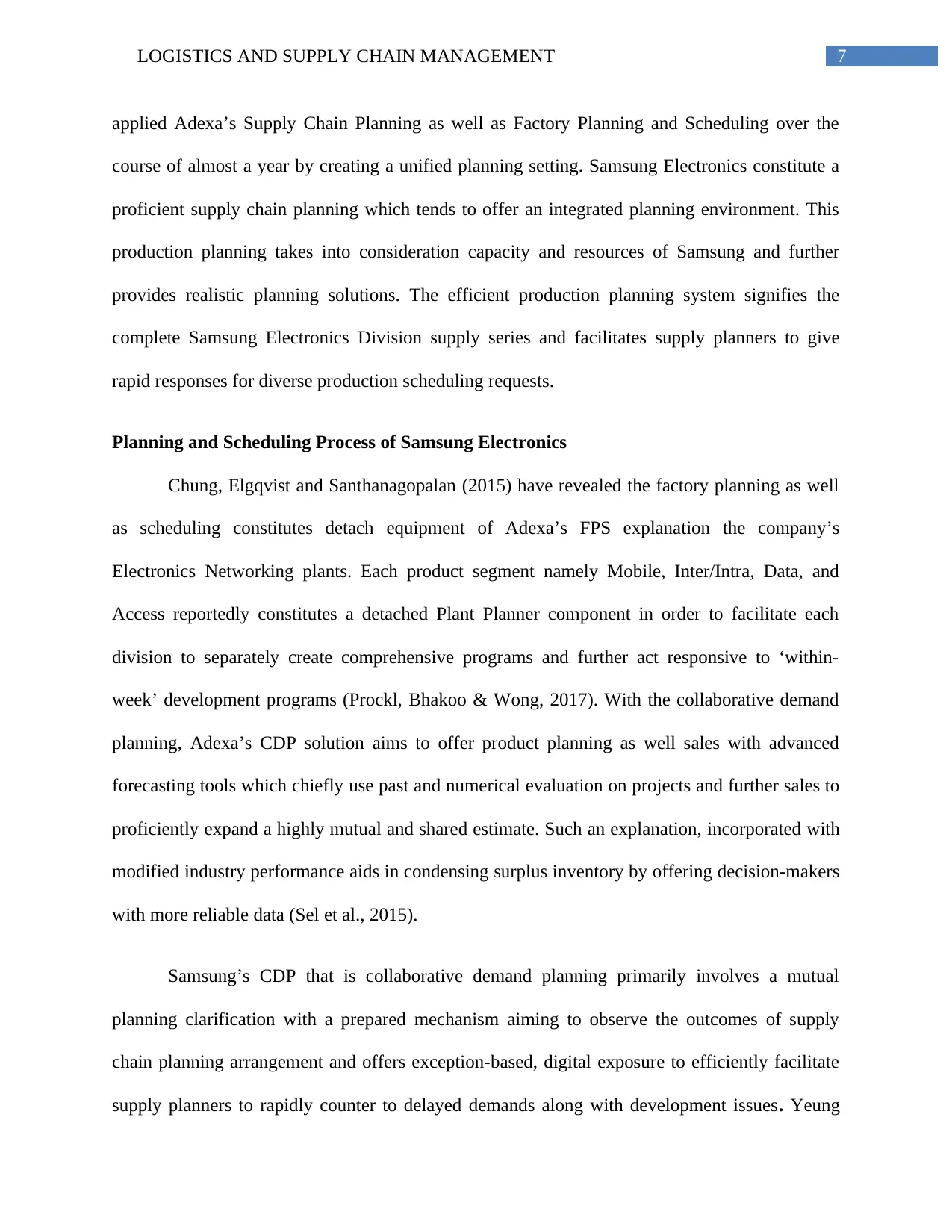
7LOGISTICS AND SUPPLY CHAIN MANAGEMENT
applied Adexa’s Supply Chain Planning as well as Factory Planning and Scheduling over the
course of almost a year by creating a unified planning setting. Samsung Electronics constitute a
proficient supply chain planning which tends to offer an integrated planning environment. This
production planning takes into consideration capacity and resources of Samsung and further
provides realistic planning solutions. The efficient production planning system signifies the
complete Samsung Electronics Division supply series and facilitates supply planners to give
rapid responses for diverse production scheduling requests.
Planning and Scheduling Process of Samsung Electronics
Chung, Elgqvist and Santhanagopalan (2015) have revealed the factory planning as well
as scheduling constitutes detach equipment of Adexa’s FPS explanation the company’s
Electronics Networking plants. Each product segment namely Mobile, Inter/Intra, Data, and
Access reportedly constitutes a detached Plant Planner component in order to facilitate each
division to separately create comprehensive programs and further act responsive to ‘within-
week’ development programs (Prockl, Bhakoo & Wong, 2017). With the collaborative demand
planning, Adexa’s CDP solution aims to offer product planning as well sales with advanced
forecasting tools which chiefly use past and numerical evaluation on projects and further sales to
proficiently expand a highly mutual and shared estimate. Such an explanation, incorporated with
modified industry performance aids in condensing surplus inventory by offering decision-makers
with more reliable data (Sel et al., 2015).
Samsung’s CDP that is collaborative demand planning primarily involves a mutual
planning clarification with a prepared mechanism aiming to observe the outcomes of supply
chain planning arrangement and offers exception-based, digital exposure to efficiently facilitate
supply planners to rapidly counter to delayed demands along with development issues. Yeung
applied Adexa’s Supply Chain Planning as well as Factory Planning and Scheduling over the
course of almost a year by creating a unified planning setting. Samsung Electronics constitute a
proficient supply chain planning which tends to offer an integrated planning environment. This
production planning takes into consideration capacity and resources of Samsung and further
provides realistic planning solutions. The efficient production planning system signifies the
complete Samsung Electronics Division supply series and facilitates supply planners to give
rapid responses for diverse production scheduling requests.
Planning and Scheduling Process of Samsung Electronics
Chung, Elgqvist and Santhanagopalan (2015) have revealed the factory planning as well
as scheduling constitutes detach equipment of Adexa’s FPS explanation the company’s
Electronics Networking plants. Each product segment namely Mobile, Inter/Intra, Data, and
Access reportedly constitutes a detached Plant Planner component in order to facilitate each
division to separately create comprehensive programs and further act responsive to ‘within-
week’ development programs (Prockl, Bhakoo & Wong, 2017). With the collaborative demand
planning, Adexa’s CDP solution aims to offer product planning as well sales with advanced
forecasting tools which chiefly use past and numerical evaluation on projects and further sales to
proficiently expand a highly mutual and shared estimate. Such an explanation, incorporated with
modified industry performance aids in condensing surplus inventory by offering decision-makers
with more reliable data (Sel et al., 2015).
Samsung’s CDP that is collaborative demand planning primarily involves a mutual
planning clarification with a prepared mechanism aiming to observe the outcomes of supply
chain planning arrangement and offers exception-based, digital exposure to efficiently facilitate
supply planners to rapidly counter to delayed demands along with development issues. Yeung
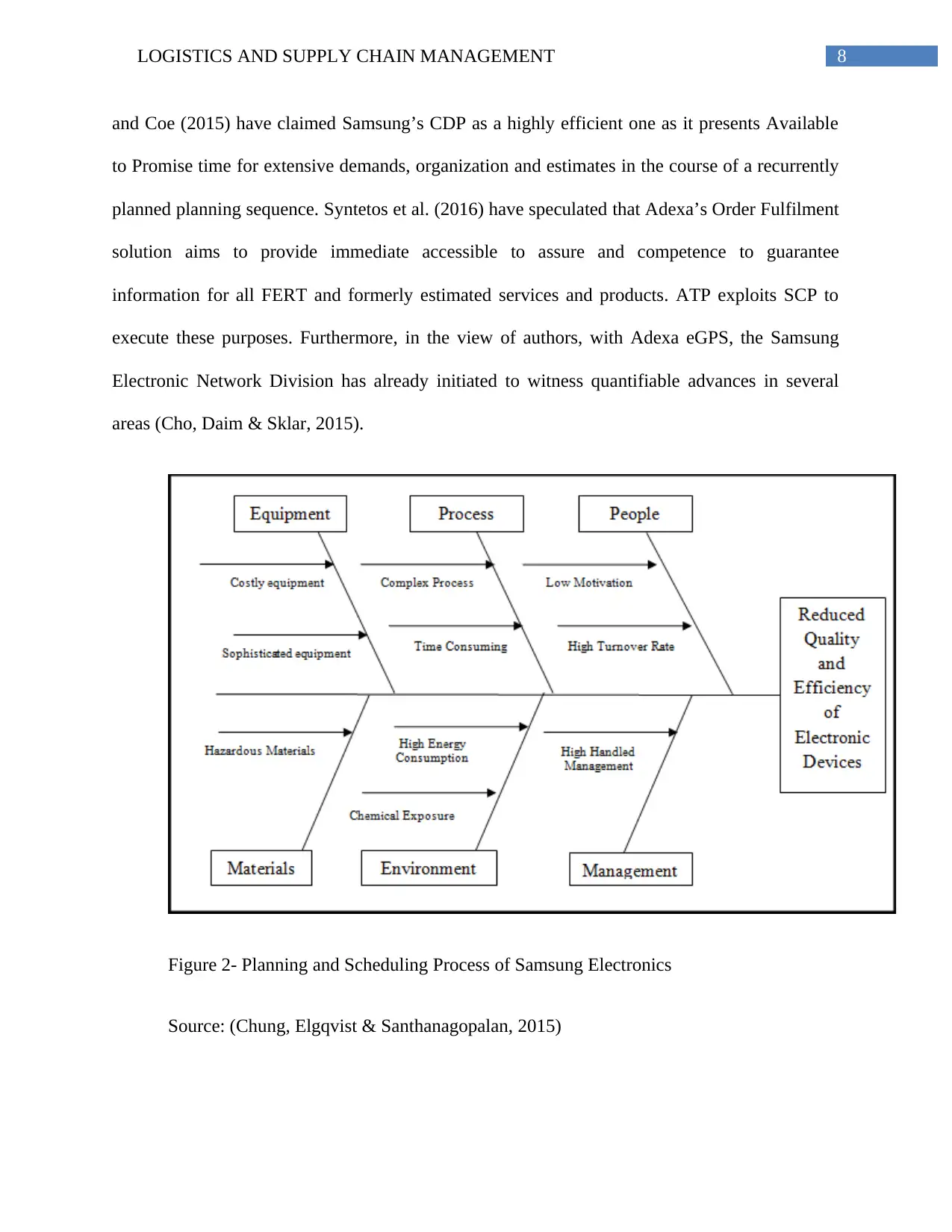
8LOGISTICS AND SUPPLY CHAIN MANAGEMENT
and Coe (2015) have claimed Samsung’s CDP as a highly efficient one as it presents Available
to Promise time for extensive demands, organization and estimates in the course of a recurrently
planned planning sequence. Syntetos et al. (2016) have speculated that Adexa’s Order Fulfilment
solution aims to provide immediate accessible to assure and competence to guarantee
information for all FERT and formerly estimated services and products. ATP exploits SCP to
execute these purposes. Furthermore, in the view of authors, with Adexa eGPS, the Samsung
Electronic Network Division has already initiated to witness quantifiable advances in several
areas (Cho, Daim & Sklar, 2015).
Figure 2- Planning and Scheduling Process of Samsung Electronics
Source: (Chung, Elgqvist & Santhanagopalan, 2015)
and Coe (2015) have claimed Samsung’s CDP as a highly efficient one as it presents Available
to Promise time for extensive demands, organization and estimates in the course of a recurrently
planned planning sequence. Syntetos et al. (2016) have speculated that Adexa’s Order Fulfilment
solution aims to provide immediate accessible to assure and competence to guarantee
information for all FERT and formerly estimated services and products. ATP exploits SCP to
execute these purposes. Furthermore, in the view of authors, with Adexa eGPS, the Samsung
Electronic Network Division has already initiated to witness quantifiable advances in several
areas (Cho, Daim & Sklar, 2015).
Figure 2- Planning and Scheduling Process of Samsung Electronics
Source: (Chung, Elgqvist & Santhanagopalan, 2015)
⊘ This is a preview!⊘
Do you want full access?
Subscribe today to unlock all pages.

Trusted by 1+ million students worldwide
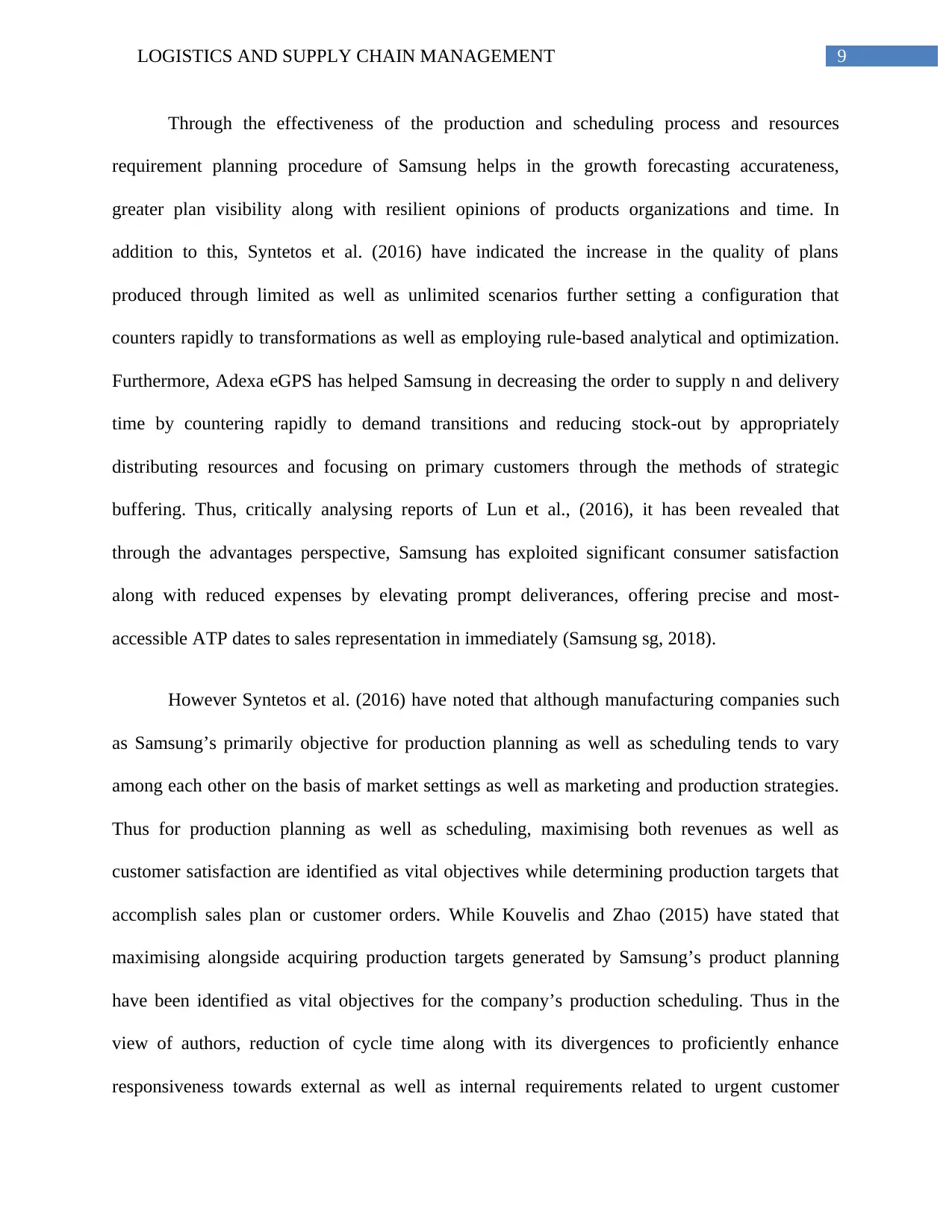
9LOGISTICS AND SUPPLY CHAIN MANAGEMENT
Through the effectiveness of the production and scheduling process and resources
requirement planning procedure of Samsung helps in the growth forecasting accurateness,
greater plan visibility along with resilient opinions of products organizations and time. In
addition to this, Syntetos et al. (2016) have indicated the increase in the quality of plans
produced through limited as well as unlimited scenarios further setting a configuration that
counters rapidly to transformations as well as employing rule-based analytical and optimization.
Furthermore, Adexa eGPS has helped Samsung in decreasing the order to supply n and delivery
time by countering rapidly to demand transitions and reducing stock-out by appropriately
distributing resources and focusing on primary customers through the methods of strategic
buffering. Thus, critically analysing reports of Lun et al., (2016), it has been revealed that
through the advantages perspective, Samsung has exploited significant consumer satisfaction
along with reduced expenses by elevating prompt deliverances, offering precise and most-
accessible ATP dates to sales representation in immediately (Samsung sg, 2018).
However Syntetos et al. (2016) have noted that although manufacturing companies such
as Samsung’s primarily objective for production planning as well as scheduling tends to vary
among each other on the basis of market settings as well as marketing and production strategies.
Thus for production planning as well as scheduling, maximising both revenues as well as
customer satisfaction are identified as vital objectives while determining production targets that
accomplish sales plan or customer orders. While Kouvelis and Zhao (2015) have stated that
maximising alongside acquiring production targets generated by Samsung’s product planning
have been identified as vital objectives for the company’s production scheduling. Thus in the
view of authors, reduction of cycle time along with its divergences to proficiently enhance
responsiveness towards external as well as internal requirements related to urgent customer
Through the effectiveness of the production and scheduling process and resources
requirement planning procedure of Samsung helps in the growth forecasting accurateness,
greater plan visibility along with resilient opinions of products organizations and time. In
addition to this, Syntetos et al. (2016) have indicated the increase in the quality of plans
produced through limited as well as unlimited scenarios further setting a configuration that
counters rapidly to transformations as well as employing rule-based analytical and optimization.
Furthermore, Adexa eGPS has helped Samsung in decreasing the order to supply n and delivery
time by countering rapidly to demand transitions and reducing stock-out by appropriately
distributing resources and focusing on primary customers through the methods of strategic
buffering. Thus, critically analysing reports of Lun et al., (2016), it has been revealed that
through the advantages perspective, Samsung has exploited significant consumer satisfaction
along with reduced expenses by elevating prompt deliverances, offering precise and most-
accessible ATP dates to sales representation in immediately (Samsung sg, 2018).
However Syntetos et al. (2016) have noted that although manufacturing companies such
as Samsung’s primarily objective for production planning as well as scheduling tends to vary
among each other on the basis of market settings as well as marketing and production strategies.
Thus for production planning as well as scheduling, maximising both revenues as well as
customer satisfaction are identified as vital objectives while determining production targets that
accomplish sales plan or customer orders. While Kouvelis and Zhao (2015) have stated that
maximising alongside acquiring production targets generated by Samsung’s product planning
have been identified as vital objectives for the company’s production scheduling. Thus in the
view of authors, reduction of cycle time along with its divergences to proficiently enhance
responsiveness towards external as well as internal requirements related to urgent customer
Paraphrase This Document
Need a fresh take? Get an instant paraphrase of this document with our AI Paraphraser
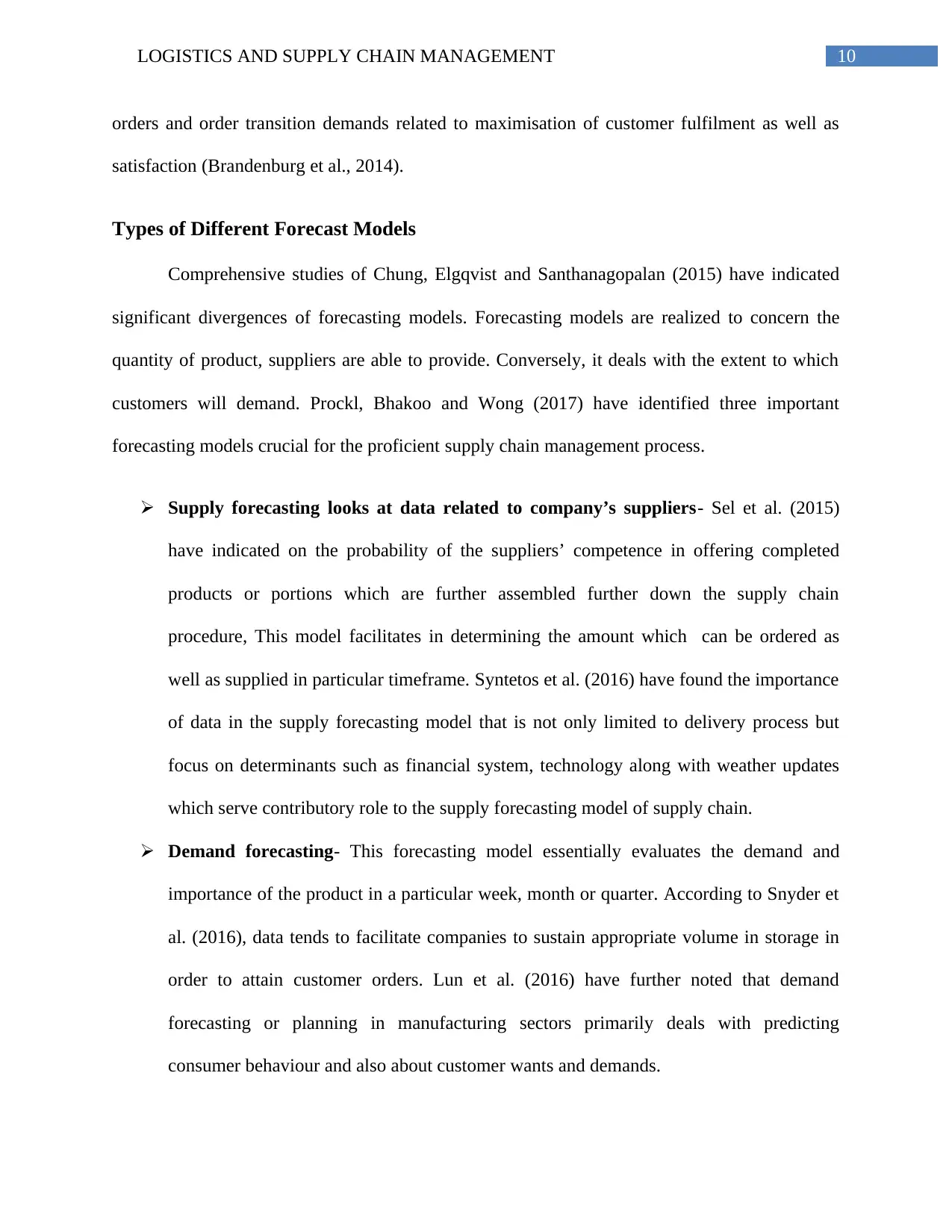
10LOGISTICS AND SUPPLY CHAIN MANAGEMENT
orders and order transition demands related to maximisation of customer fulfilment as well as
satisfaction (Brandenburg et al., 2014).
Types of Different Forecast Models
Comprehensive studies of Chung, Elgqvist and Santhanagopalan (2015) have indicated
significant divergences of forecasting models. Forecasting models are realized to concern the
quantity of product, suppliers are able to provide. Conversely, it deals with the extent to which
customers will demand. Prockl, Bhakoo and Wong (2017) have identified three important
forecasting models crucial for the proficient supply chain management process.
Supply forecasting looks at data related to company’s suppliers- Sel et al. (2015)
have indicated on the probability of the suppliers’ competence in offering completed
products or portions which are further assembled further down the supply chain
procedure, This model facilitates in determining the amount which can be ordered as
well as supplied in particular timeframe. Syntetos et al. (2016) have found the importance
of data in the supply forecasting model that is not only limited to delivery process but
focus on determinants such as financial system, technology along with weather updates
which serve contributory role to the supply forecasting model of supply chain.
Demand forecasting- This forecasting model essentially evaluates the demand and
importance of the product in a particular week, month or quarter. According to Snyder et
al. (2016), data tends to facilitate companies to sustain appropriate volume in storage in
order to attain customer orders. Lun et al. (2016) have further noted that demand
forecasting or planning in manufacturing sectors primarily deals with predicting
consumer behaviour and also about customer wants and demands.
orders and order transition demands related to maximisation of customer fulfilment as well as
satisfaction (Brandenburg et al., 2014).
Types of Different Forecast Models
Comprehensive studies of Chung, Elgqvist and Santhanagopalan (2015) have indicated
significant divergences of forecasting models. Forecasting models are realized to concern the
quantity of product, suppliers are able to provide. Conversely, it deals with the extent to which
customers will demand. Prockl, Bhakoo and Wong (2017) have identified three important
forecasting models crucial for the proficient supply chain management process.
Supply forecasting looks at data related to company’s suppliers- Sel et al. (2015)
have indicated on the probability of the suppliers’ competence in offering completed
products or portions which are further assembled further down the supply chain
procedure, This model facilitates in determining the amount which can be ordered as
well as supplied in particular timeframe. Syntetos et al. (2016) have found the importance
of data in the supply forecasting model that is not only limited to delivery process but
focus on determinants such as financial system, technology along with weather updates
which serve contributory role to the supply forecasting model of supply chain.
Demand forecasting- This forecasting model essentially evaluates the demand and
importance of the product in a particular week, month or quarter. According to Snyder et
al. (2016), data tends to facilitate companies to sustain appropriate volume in storage in
order to attain customer orders. Lun et al. (2016) have further noted that demand
forecasting or planning in manufacturing sectors primarily deals with predicting
consumer behaviour and also about customer wants and demands.
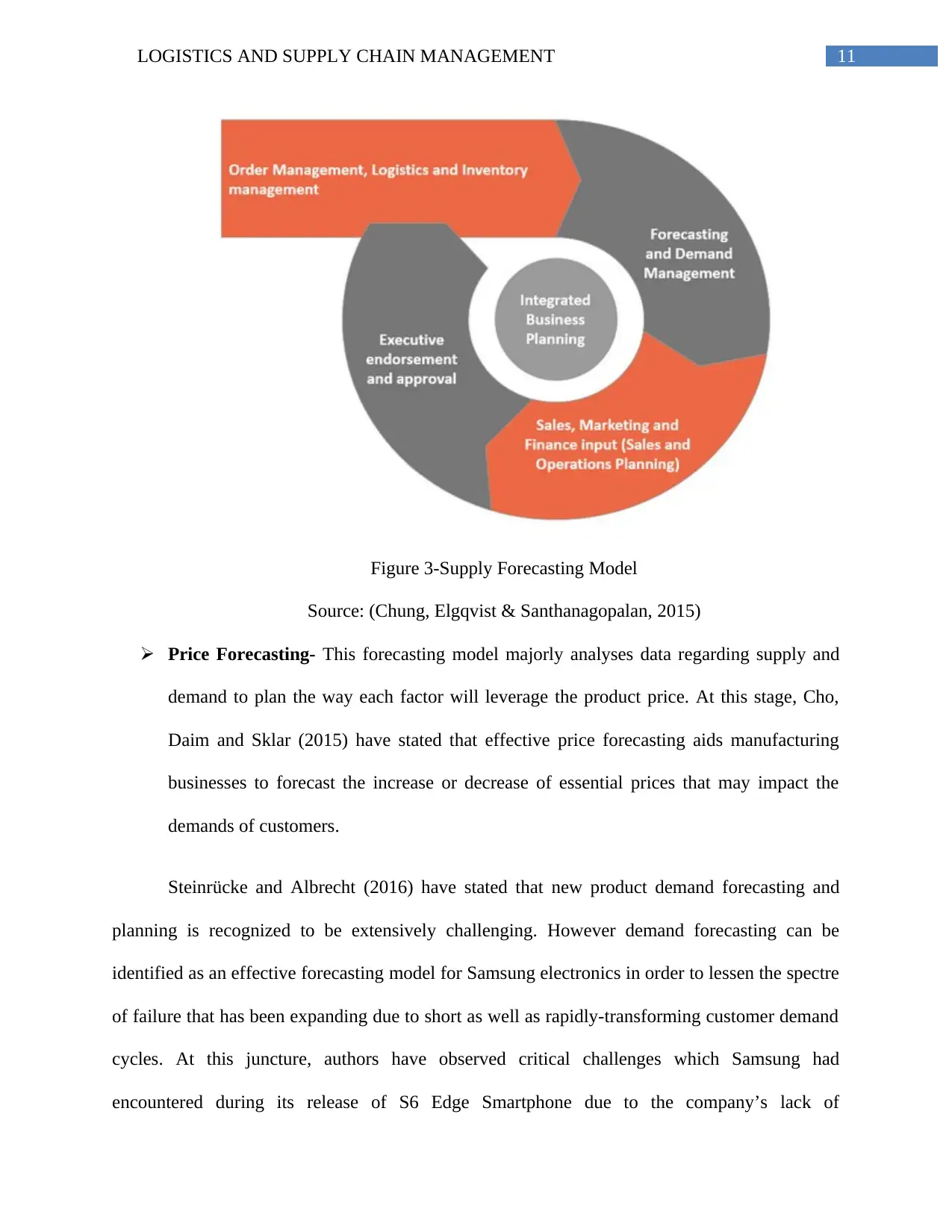
11LOGISTICS AND SUPPLY CHAIN MANAGEMENT
Figure 3-Supply Forecasting Model
Source: (Chung, Elgqvist & Santhanagopalan, 2015)
Price Forecasting- This forecasting model majorly analyses data regarding supply and
demand to plan the way each factor will leverage the product price. At this stage, Cho,
Daim and Sklar (2015) have stated that effective price forecasting aids manufacturing
businesses to forecast the increase or decrease of essential prices that may impact the
demands of customers.
Steinrücke and Albrecht (2016) have stated that new product demand forecasting and
planning is recognized to be extensively challenging. However demand forecasting can be
identified as an effective forecasting model for Samsung electronics in order to lessen the spectre
of failure that has been expanding due to short as well as rapidly-transforming customer demand
cycles. At this juncture, authors have observed critical challenges which Samsung had
encountered during its release of S6 Edge Smartphone due to the company’s lack of
Figure 3-Supply Forecasting Model
Source: (Chung, Elgqvist & Santhanagopalan, 2015)
Price Forecasting- This forecasting model majorly analyses data regarding supply and
demand to plan the way each factor will leverage the product price. At this stage, Cho,
Daim and Sklar (2015) have stated that effective price forecasting aids manufacturing
businesses to forecast the increase or decrease of essential prices that may impact the
demands of customers.
Steinrücke and Albrecht (2016) have stated that new product demand forecasting and
planning is recognized to be extensively challenging. However demand forecasting can be
identified as an effective forecasting model for Samsung electronics in order to lessen the spectre
of failure that has been expanding due to short as well as rapidly-transforming customer demand
cycles. At this juncture, authors have observed critical challenges which Samsung had
encountered during its release of S6 Edge Smartphone due to the company’s lack of
⊘ This is a preview!⊘
Do you want full access?
Subscribe today to unlock all pages.

Trusted by 1+ million students worldwide
1 out of 17
Related Documents
Your All-in-One AI-Powered Toolkit for Academic Success.
+13062052269
info@desklib.com
Available 24*7 on WhatsApp / Email
![[object Object]](/_next/static/media/star-bottom.7253800d.svg)
Unlock your academic potential
Copyright © 2020–2025 A2Z Services. All Rights Reserved. Developed and managed by ZUCOL.





